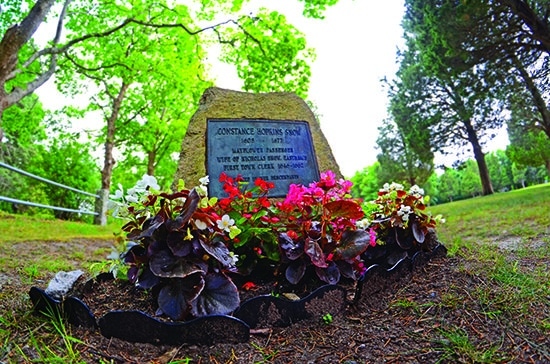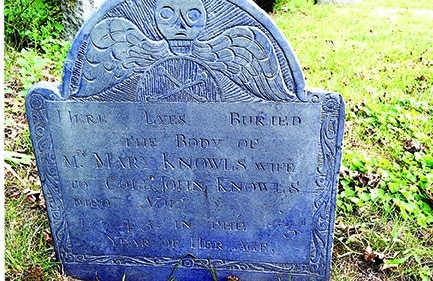
An afternoon at Eastham’s Cove Burying Ground
Cape Cod Life / September/October 2016 / History, Recreation & Activities
Writer: Valerie Prancevic / Photographer: Paige Biviano
An afternoon at Eastham’s Cove Burying Ground

Cape Cod Life / September/October 2016 / History, Recreation & Activities
Writer: Valerie Prancevic / Photographer: Paige Biviano

Photograph by Paige Biviano
During a recent visit to Cape Cod, my husband and I decided to visit the Cove Burying Ground in Eastham, and we were greeted enthusiastically by Robert Carlson, who was clearly looking forward to telling us the story of the historic cemetery. Carlson, 82, is a member of the Eastham Cemetery Commission, and volunteers as a tour guide at Cove. He sparked with energy, and mentioned with pride that he was related to Thomas Paine, who built the Eastham windmill (in Plymouth) in 1680, and is likely buried at Cove.
Founded in the 1600s, the Cove Burying Ground—located at the intersection of Route 6A and Corliss Way—is probably the final resting place for three Mayflower passengers: Constance Hopkins Snow (1605-1677), Joseph Rogers (1608-1678), and Giles Hopkins (1607-1690), Constance and Giles being brother and sister. It is not known where the siblings’ exact interments are; The Mayflower Society put the current markers in place in 1966.
Quickly recapping the Pilgrims’ story, there were various reasons why 102 individuals boarded the Mayflower in Harwich, England in July of 1620. Some were fleeing the law in England, but most of the ship’s passengers were Puritans who wanted to practice a faith that was not allowed in their homeland. Arriving in the New World in November of that year—first in Provincetown Harbor and later in Plymouth—53 of the ship’s passengers did not survive their first winter in America. While the Cove Burying Ground only has monuments for the three aforementioned Pilgrims, the cemetery has about 150 unmarked graves, meaning it’s possible others are buried there, but Carlson says most of the Mayflower passengers likely died in Plymouth, Boston, or elsewhere.
Carlson led us around the two-acre cemetery, bending down nimbly to show us some stones with extraordinary markings. We asked about the skull and face carvings that were prevalent.
“Great question,” Carlson responded, with shining eyes and a raised index finger. Preachers of the era commonly pounded the pulpit on the perils of eternal damnation and the consequences of sin—and it is said that one local pastor, a certain Rev. Samuel Treat, could be heard from a great distance. The reverend is laid to rest at Cove, alongside some of his deceased congregants who may have gone to their graves half deaf.
To put the fear of death into the living, Carlson says a skull and crossbones was etched into gravestones, a constant reminder of the inevitable. But, ever the optimists, and giving themselves some hope of escaping the fires of hell, some gravestones also featured an angel’s wings extending from an image of a face. An hourglass etched onto a marker was yet another reminder to any who would view it that time was running out.
“It was considered disrespectful to step on a grave [in the 1600s],” Carlson says. When children are on his tours, he often adds the following, in jest: “They don’t care now, of course, but unless you hear some cracking noises under your feet, it’s OK to step where you want. That’s why a small footstone was frequently added with the initials of the person to mark the boundaries.”
We noticed there seemed to be differences in the years of death on some of the gravestones. “I’m glad you noticed that,” Carlson says, adding that that was when the shift was taking place from the Julian calendar to the Gregorian calendar, circa 1752. “Take this one, for example: Jonathan Sparrow,” Carlson says. “You notice that he died in 1706 under the Julian calendar, but the Gregorian calendar is one year later, so both years are listed on the stone.”

Photograph by Paige Biviano
“Let me show you something else interesting,” our guide continues. “See those tombstones over there?” he indicated with a wave of his hand. “Notice they are brown instead of the usual gray. If someone has that kind of stone, it suggests the stone might have been brought in, through family connections, from the quarries of the Connecticut River Valley which produced much of the brownstone used in buildings that are historic today.”
“Now here’s a lady who had some connections in town,” Carlson said as we strolled on. “Her name was Marcy Freeman, and she was the granddaughter of William Brewster after whom the town of Brewster was named. You can see that her stone has an angel face carving, plus wings, along with, of course, the skull. Again, they tried to have hope by covering all bases. Marcy married John Freeman whose father, Edmund Freeman, founded Sandwich. And look at her footstone! Instead of just her initials, she has a winged skull and two pairs of crossed bones. But her daughter over there, Bennet Paine, only had a rock for her marker. Very plain.”
We came upon another grave with a story. “Benjamin Paine, of the Paine family: We think this is the oldest homemade gravestone on the whole Cape with an individual’s full name on it. You can barely see it, but it’s all there,” Carlson says, pointing out Paine’s short life span (1697 to 1713).
“And you’ll notice something else about some of the skull carvings around here,” Carlson adds. “A carver from Boston by the name of Joseph Lamsom (d. 1722) made his skulls longer and thinner, with more details. That’s how you can tell it was carved by a Lamsom, a family of stone masons which spanned generations.”
Loaded with great knowledge and a new appreciation for an ancient but not forgotten Cape Cod graveyard, our tour was complete. We thanked our guide for his time and said our goodbyes. Some visitors started to meander among the stones as we were leaving, and Carlson sprinted over to meet his new audience. We knew he would be anxious to tell the stories again and again.
For information about the Cove Burying Ground in Eastham, including tours, visit capecodgravestones.com, or send an email to Robert Carlson at rpcarlson@comcast.net.
A resident of Santa Maria, California, Valerie Prancevic loves the history of Cape Cod and is a regular visitor. She and her husband are planning a September trip to Brewster to enjoy some cocktails and the sunsets on the beach.



